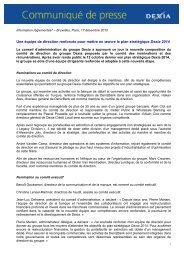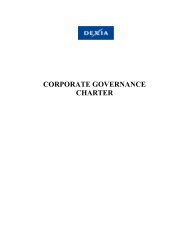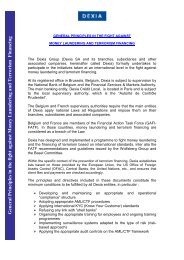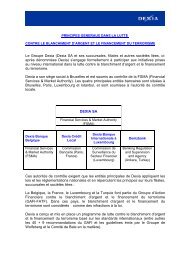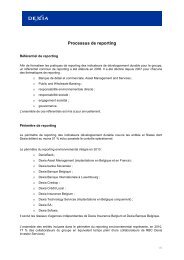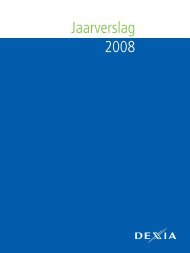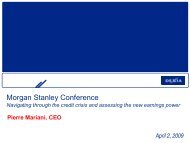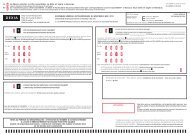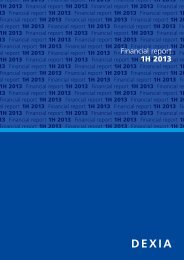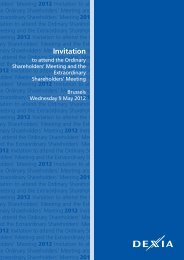Annual report 2010 - Dexia.com
Annual report 2010 - Dexia.com
Annual report 2010 - Dexia.com
- No tags were found...
You also want an ePaper? Increase the reach of your titles
YUMPU automatically turns print PDFs into web optimized ePapers that Google loves.
Capital managementEconomic capitalEconomic capital adequacyManagement <strong>report</strong>Consolidatedfinancial statementsEconomic capital is defined as the potential deviation of theGroup’s economic value in relation to the value expected at agiven interval of confidence and time horizon. The economiccapital quantification process is organised in three phases: riskidentification (definition and cartography updated annually upto a local level), their assessment (essentially on the basis ofstatistical methodologies) and their aggregation on the basisof an inter-risks diversification matrix. The majority of risks arecapitalised in relation to a measure of expected loss; certainrisks are not however capitalised if other management modes(limits, scenarios, governance and so on) are considered moreappropriate to cover them.Capitalised risks are assessed at a high level of severity(99.97% at one year).During <strong>2010</strong>, economic capital <strong>report</strong>ing was totallycentralised, in line with the new Group organisation.A series of methodological evolutions was made to calculationmethods in order to learn from the crisis, and to respond tointernal re<strong>com</strong>mendations as well as those from the regulatorswho audited the mechanism at the end of 2009.<strong>Dexia</strong>’s economic capital is EUR 14,022 million at year-end<strong>2010</strong>.Credit risk represents approximately one half of the utilisationof economic capital.Market risk, which includes interest-rate risks, foreignexchangerisks and the equity-price risk, is the second riskfactor.Created in 2009, the Economic Performance AnalysisCommittee (EPAC) manages the capital adequacy processand in this context has to propose solutions suited to <strong>Dexia</strong>strategy. On a quarterly basis, the EPAC examines (regulatoryand economic) ratios, limits and triggers defined in the riskappetite policy and the budget framework, and possibledivergences in relation to forecasts. It assesses the Group’scapacity to absorb them and studies action proposals. Theinformation in the EPAC <strong>report</strong> is established jointly by theRisks and Finance support lines; the Management Boardreads it.ECONOMIC CAPITAL BY TYPE OF RISKAS AT 31 DECEMBER <strong>2010</strong>OperationalriskMarketrisk32%17%51%CreditriskOperational risk (including <strong>com</strong>mercial risk) is the third riskfactor.ECONOMIC CAPITAL BY BUSINESS LINEAS AT 31 DECEMBER <strong>2010</strong>Additional information <strong>Annual</strong> financial statementsThe Legacy division consumes almost one quarter of economiccapital. It includes the bond portfolio in run-off (<strong>com</strong>prisingthe former credit spread portfolio, the public bond portfolioand some trading portfolios), the Financial Products portfolioand some non-core public loans as well as off-balance sheet<strong>com</strong>mitments, mainly liquidity lines in the United States.Public and Wholesale Banking and Retail and CommercialBanking both consume approximately 20% of capital. AssetManagement and Services consume almost 10% of capital,and the remainder is allocated to the Group Center (ALM,holdings…).LegacyGroupCenter23%28%9%19%21%Public andWholesaleBankingRetail andCommercialBankingAssetManagementand Services98<strong>Dexia</strong> <strong>Annual</strong> <strong>report</strong> <strong>2010</strong>



